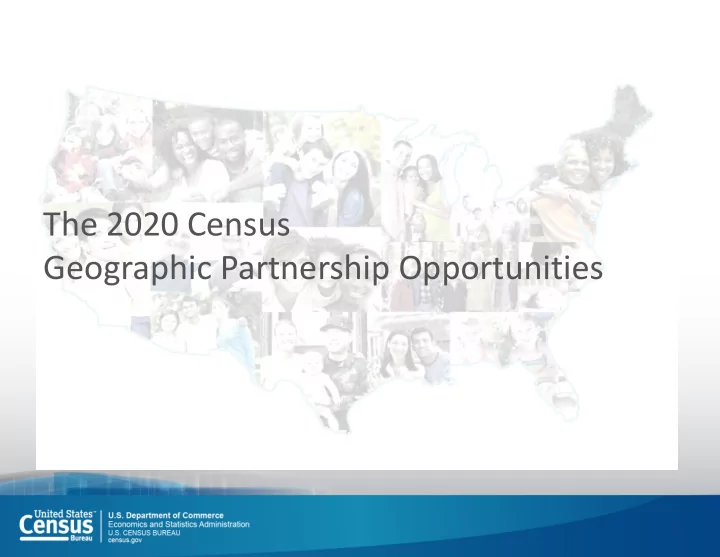

The 2020 Census Geographic Partnership Opportunities
Address List Maintenance 2010 - 2020 On-going Maintenance and Update Address Canvassing US Postal Service’s Delivery Sequence File Nationwide In-Office LUCA (DSF) Address Canvassing Updates from tribal, Opportunity to In-Field Address Canvassing state, and local review and update Annual In-Field data government address lists the Census collection, checks, and tests and commercial address Bureau’s address lists ( GSS ) list for the 2020 Continuous identification Census of stability and change 5
Local Update of Census Addresses LUCA What is It? An opportunity for state, local and tribal governments to review the list of addresses that will be used to conduct the Decennial Census Why Participate? Ensure the Census Bureau has an accurate list of housing units for your community to facilitate the best count possible.
Confidentiality and Security Information provided to/from LUCA is covered under Title 13 of the United States Code which: Requires the Census Bureau to ensure confidential treatment of census-related information, including individual addresses and structure coordinates Requires all liaisons, reviewers, and anyone with access to Title 13 materials abide by Confidentiality and Security Guidelines Requires the Census Bureau maintain the confidentiality of all information it collects 4
What’s New for 2020 LUCA Provides the digital address list in convenient standard software formats Includes ungeocoded address records for state and county participants Requires residential multi-unit structure identifiers (e.g., Apt 1, Unit A2, #3001, etc.) Includes residential structure coordinates, if available Allows participants to submit residential structure coordinates, if available Allows participants to submit non-city style addresses with corresponding map spot 5
Who can participate in LUCA Federally recognized tribes with a reservation and/or off-reservation trust land States Counties Incorporated places Cities, towns, boroughs, townships Regional planning agencies or other agencies designated by a local government 6
LUCA Tools 2020 LUCA Address Block Count List Provides address counts by census block so you can compare your counts to assess whether you’d like to participate: https://www.census.gov/geo/partnerships/luca.html 11
LUCA Tools Census Geocoder Takes individual or a file of addresses and returns the same list with coordinates and census geography attached. https://geocoding.geo.census.gov/ 12
Participation Methods Geographic Update Partnership Software (GUPS) Digital Format - Address List and Maps Paper Format - Address List and Maps 9
Next Steps (Participant) Prepare (now!) Register to participate (July – December 15, 2017) Attend a training workshop (Fall/Winter 2017) In-person workshops Self-training aids and Webinars available online Conduct your LUCA review (Feb-April 2018) 120 calendar days upon receipt of materials to complete review 10
Preparation - 2020 LUCA Schedule 11
Boundary & Annexation Survey BAS What is It? An annual survey of all governments to collect legal boundaries in effect on January 1st of the BAS year. Why Should your Government Participate? Boundaries are used to tabulate data for: Decennial Census (year ending in 0) • Economic Censuses (years ending in 2, 7) • Population Estimates Program (annually) • American Community Survey (annually) •
Boundary & Annexation Survey BAS Submission Deadlines: March 1 of Survey Year: updates reflected in all subsequent censuses, surveys and estimates published for that year May 31 of Survey Year: updates reflected in the following year’s BAS Participation Tools: GUPS (Geographic Update Partnership Software ), your GIS, paper maps Review Online NOW using TIGERweb: https://tigerweb.geo.census.gov/tigerweb/
2020 Participant Statistical Areas Program PSAP What is it? An Opportunity for regional planners to review and update Census Tracts, Block Groups and Census Designated Places (CDPs) in preparation for 2020 data tabulation and publication in 2021. How to Participate? Census staff contact Tribal planners, Council of Government officials, or County planners who will redefine the statistical map of their jurisdiction using census provided software tools and data.
2020 Participant Statistical Areas Program PSAP Program Implementation 2020 PSAP plan created by the Census Bureau for review (new for 2020) 2 Phases: Delineation (120-days) Verification (120-days) Includes both Tribal and Standard Statistical Areas Schedule Spring 2017: Program announcement Late 2018: Plan delineation Late 2019: Plan verification
Boundary Validation Program (BVP) January 2020 Highest Elected Officials (HEO) and Tribal Leaders (TL) are provided maps of jurisdictional boundaries for initial review and update in March 2020 HEOs and TLs complete final validation of boundary changes provided during BVP or BAS by May 2020 Boundaries as of January 1, 2020 will be used for 2020 Census data tabulation 16
How you can prepare for geographic programs: Review your Boundaries now and respond to the 2017 BAS LUCA provides only those addresses inside your jurisdiction’s boundaries, so if your boundaries are incorrect, you may not see Thank you your entire address list. See: https://tigerweb.geo.census.gov/tigerweb/ Get your local address list in shape for LUCA Determine unit designations for multi-unit buildings Determine residential vs. commercial addresses Geocode to current Census Tract/block See: https://geocoding.geo.census.gov/ Contact the PSAP lead agency for your Jurisdiction Begin a review of 2010 tracts, block groups, and CDPs that need revision for 2020
Recommend
More recommend